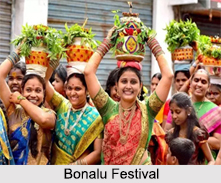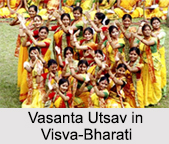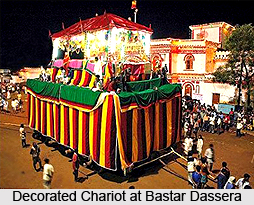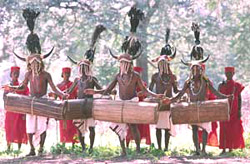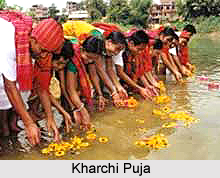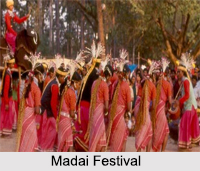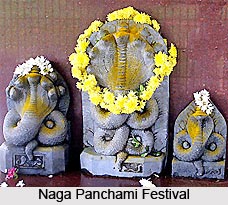 Nagaland Temple Festivals are mainly tribal in nature and it is very emphatically asserted that the people of Nagaland are vibrant and earthly people. They believe life itself to be a celebration. All the Nagaland Temple Festivals are celebrated with abundant fervor and enthusiasm.
Nagaland Temple Festivals are mainly tribal in nature and it is very emphatically asserted that the people of Nagaland are vibrant and earthly people. They believe life itself to be a celebration. All the Nagaland Temple Festivals are celebrated with abundant fervor and enthusiasm.
Life in the state of Nagaland revolves around fairs and festivals, since there is nothing much to do other than routine chores of a day. The tribal population of Nagaland celebrates their distinct seasonal festivals with a spirited display of color and a feast of music. They regard their festivals, as honored and to they compulsorily participate in all Nagaland Temple Festivals. The prime occupation of the state is agriculture and hence most of the Nagaland Temple Festivals revolve around agriculture. The festive celebrations of the Nagas are distinct with rare gusto, which in turn astounds the onlookers with awe and admiration. The predominant theme of all the Nagaland Temple Festivals remains to be the offering of prayers to a Supreme Being having different names in different Naga dialects. The chief man of the village prays to the spirit of the Gods with sacrifices for a bountiful surrender of crops.
Moatsu
Moatsu is one of the Nagaland Temple Festivals, celebrated with much pomp and show by the Ao tribe in the state of Nagaland in the first week of May every year and is one of the most famous festivals of Nagaland. During this Nagaland Temple Festival, the rites and rituals are performed by the Nagas with much veneration. After the sowing is over the Nagas observe Moatsu Song with great excitement and energy. This festival not only provides the tribe a period of recreation and amusement but is marked by the collection of cultural performances within the temples. The festive celebrations, last for a span of one week. The festivities also involve a symbolic celebration called the Sangpangtu, where a big fire is lit and men and women sit and sing around it.
Tsungrem Mong
Tsungrem Mong is one of the cherished Nagaland Temple Festivals and is a much-awaited festival of the Ao tribe. This festival is observed in the month of August according to the English calendar, just after the millet has been sown. This is one of the special thanksgiving festivals of Nagaland and is also considered as a prayer for a bountiful yield of crops.
Nazu
Nazu is a grand festival, celebrated by the Pochury tribe of Nagaland with much enthusiasm. This festival is reckoned as one of the most important festivals of Nagaland. Observed for a span of ten days at a stretch, this festival is enjoyed with much glitter and gaiety. The tribe also participates in several cultural performances during this auspicious occasion. The dancers of this Nagaland Temple Festival adorn themselves with vibrant colored attires and glittering accessories. The harmonious movements of hands and legs along with the songs of different tunes and beats are especially noticeable in the dance form made by them.
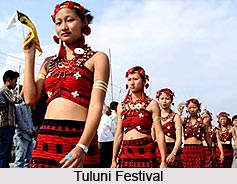
Sekrenyi
Sekrenyi is one of the most important festivals of Nagaland, celebrated in the month of February by the Angamis tribe. This Nagaland Temple Festival, also known as Phousyni by the Angamis is celebrated for a span of ten days. The tribe with much veneration observes the religious rites and rituals. The best part of the festival is the Thekra Hie where the adolescences of the village accumulate and sing traditional songs throughout the day. The important part of the ceremony is conducted on the eighth day when the bride pulling or gate pulling is performed or inter-village visits are replaced. Till the festive celebrations get over the peasants stop the field activities, as they remain totally absorbed in the glee.
Tuluni
Tuluni is another Nagaland Temple Festival of the Sumi Nagas. This grand festival is celebrated during the second week of July, or the season of bounty in the state. Grand feasts and banquets mark the festive celebrations. This auspicious event holds special religious significance as well. Rice beer is served to all in a goblet made with the leaf of plantain. During this Nagaland Temple Festival, the youth engage as couples and then exchange basketful of gifts. It is also a time of uncontrolled merriment for the baby-sitters.
Yemshe
Yemshe is the grand festival celebrated by the Pochury tribe of Nagaland in the month of October. Besides, greeting each other for the arrival of the new harvest with much exuberance and ebullience, the people also make offerings to the deities in temples. The rich and the poor ceremonialise this festival with much fun and frolic, praying for a bounteous harvest after a yearlong of hard toil. The filed activities are halted until the festival gets over. The village spokesman following which first announces the arrival of the festival; the first part of rituals takes place. The last day of the feast will be impressively observed as the feast-cleansing day. This festival is celebrated in two phases, namely the Big Yemshe and the Small Yemshe. The Big Yemshe is the festival for preparations all around as the village youth cleanses the whole village. The purification of the house and a ritual feast exemplifies the Small Yemshe.
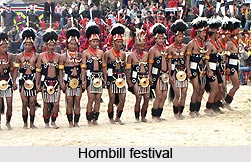
Hornbill festival
Hornbill festival is one among the Nagaland Temple Festivals and is organized by the Government of Nagaland. With grand celebration in Kohima every year between the first and the fifth days in the month of December, this is one of the colorful festivals of Nagaland and it mainly aims at protecting and sustaining the richness of the Naga heritage and traditions. However some offerings are done to the temple deities.
Bushu
Bushu is a post harvest festival, celebrated by the Kachari tribe belonging to Nagaland in the month of January according to the English calendar. This grand festival is categorised into three different varieties namely, `Hangsho`, `Surem` and `Jidep Jiba`. A feast of rice and meat is followed by other social activities that are the main features of this grand festival.
Several competitions, traditional sports and other cultural activities are held during the Nagaland Temple Festivals.
